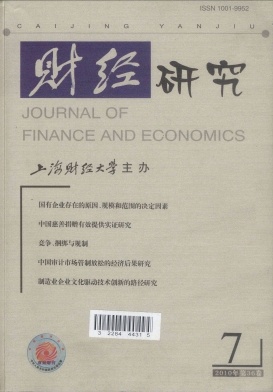技术差距双面效应与主导技术进步模式转换
财经研究 2010 年 第 36 卷第 07 期, 页码:40 - 49
摘要
参考文献
摘要
文章利用拓展的R&D增长模型和中国2000-2006年省际面板数据证明了由于技术差距对技术后发优势的双面效应,技术差距与技术进步和经济增长呈倒"U"形关系,一定程度以内的技术差距有利于技术进步,但过大的技术差距并不利于技术进步;而主导技术进步模式随着技术差距的缩小从自主研发到模仿,再到自主研发转换。其政策含义是:根据技术差距选择适宜的主导技术进步模式有助于实现技术赶超。
[1] 张景安.实现由技术引进为主向自主创新为主转变的战略思考[J].中国软科学,2003,(11) :1-5.
[2] 周天勇.促进自主创新应正确处理八大关系[N].光明日报,2005-03-01.
[3] 林毅夫,张鹏飞.适宜技术、技术选择与发展中国家的经济增长[J].经济学季刊,2005,5(4) :985-1006.
[4] 冯雁秋.后发优势悖论与中国的技术战略选择[J].世界经济,2000,(7) :44-49.
[5] 易先忠,张亚斌.技术差距与人力资本约束下的技术进步模式[J].管理科学学报, 2008,(6) :64-75.
[6] 张军,吴桂英,张吉鹏.中国省际物质资本存量估算:1952--2000[J].经济研究,2002,(10) :35-44.
[7] Keller W. International technology diffusion[J]. Journal of Economic Literature, 2004, 42(3) :752--782.
[8] Barro R, Sala-I-Martin X. Technological diffusion, convergence, and growth[J]. Journal of Economic Growth, 1997, (2) : 1--27.
[9] Bin Xu. Multinational enterprises, technology diffusion, and host country productivity growth[J]. Journal of Development Economics, 2000, 62 (2) : 477--493.
[10] Cohen W, D Levinthal. Innovation and learning: The two faces of R&D[J]. Economic Journal, 1989, 99(397) :569--596.
[11] Vandenbussche, Aghion, Meghir. Growth, distance to frontier and composition of human capital[J]. Journal of Economic Growth, 2006, 11 (2) : 97--127.
[12] Acemoglu D, Aghion P, Zilibotti F. Distance to frontier, selection, and economic growth[J]. Journal of the European Economic Association, 2006, 4 (1) : 37--74.
[13] Chen Yongmin, Puttitanun Thitima. Intellectual property rights and innovation in developing countries[J]. Journal of Development Economics, 2005, 78(2) : 474--493.
[2] 周天勇.促进自主创新应正确处理八大关系[N].光明日报,2005-03-01.
[3] 林毅夫,张鹏飞.适宜技术、技术选择与发展中国家的经济增长[J].经济学季刊,2005,5(4) :985-1006.
[4] 冯雁秋.后发优势悖论与中国的技术战略选择[J].世界经济,2000,(7) :44-49.
[5] 易先忠,张亚斌.技术差距与人力资本约束下的技术进步模式[J].管理科学学报, 2008,(6) :64-75.
[6] 张军,吴桂英,张吉鹏.中国省际物质资本存量估算:1952--2000[J].经济研究,2002,(10) :35-44.
[7] Keller W. International technology diffusion[J]. Journal of Economic Literature, 2004, 42(3) :752--782.
[8] Barro R, Sala-I-Martin X. Technological diffusion, convergence, and growth[J]. Journal of Economic Growth, 1997, (2) : 1--27.
[9] Bin Xu. Multinational enterprises, technology diffusion, and host country productivity growth[J]. Journal of Development Economics, 2000, 62 (2) : 477--493.
[10] Cohen W, D Levinthal. Innovation and learning: The two faces of R&D[J]. Economic Journal, 1989, 99(397) :569--596.
[11] Vandenbussche, Aghion, Meghir. Growth, distance to frontier and composition of human capital[J]. Journal of Economic Growth, 2006, 11 (2) : 97--127.
[12] Acemoglu D, Aghion P, Zilibotti F. Distance to frontier, selection, and economic growth[J]. Journal of the European Economic Association, 2006, 4 (1) : 37--74.
[13] Chen Yongmin, Puttitanun Thitima. Intellectual property rights and innovation in developing countries[J]. Journal of Development Economics, 2005, 78(2) : 474--493.
引用本文
易先忠. 技术差距双面效应与主导技术进步模式转换[J]. 财经研究, 2010, 36(7): 40–49.
导出参考文献,格式为:





 6170
6170  3733
3733

